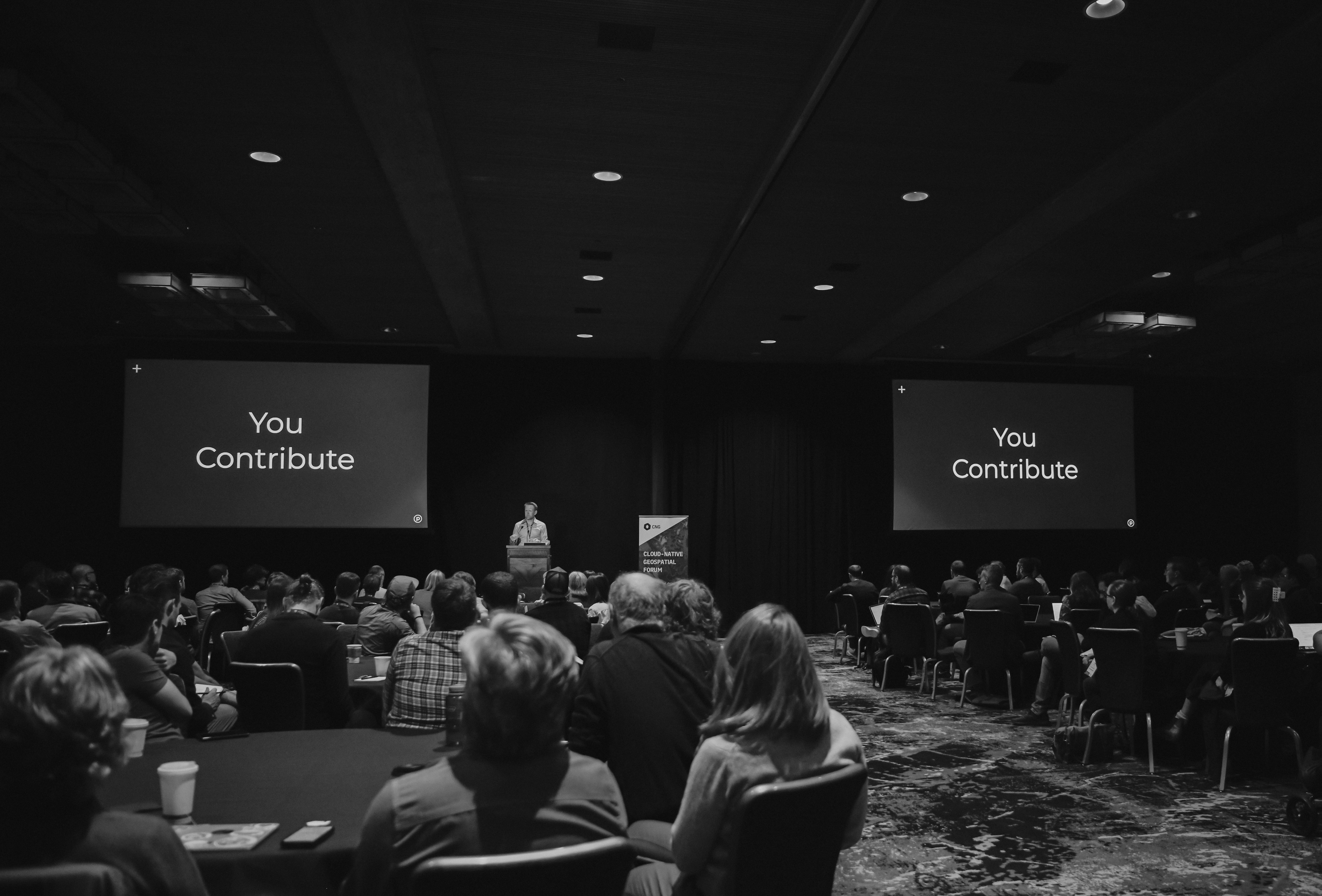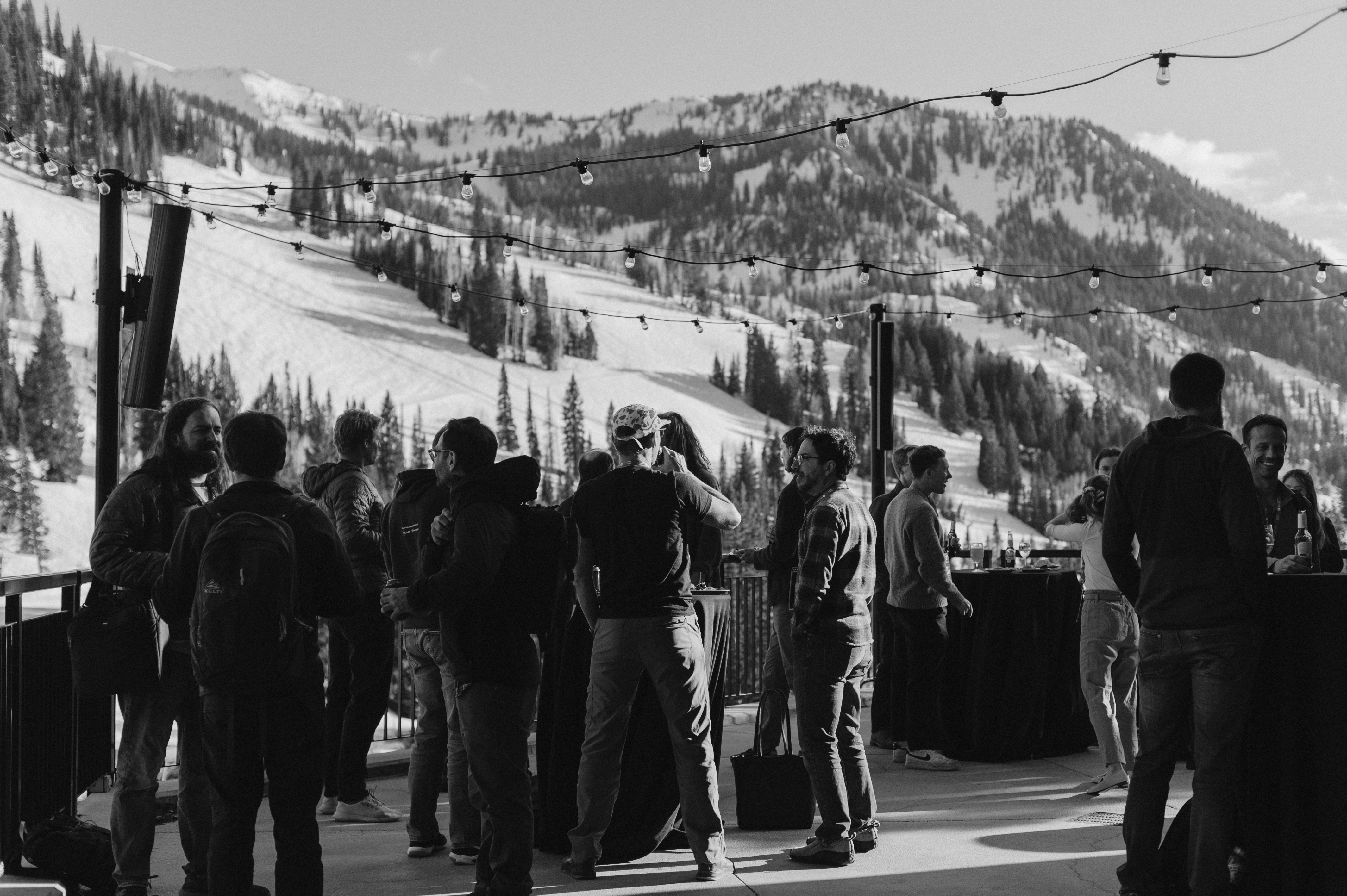Recapping CNG Conference 2025: Cloud-Native Geospatial IRL

Chris Holmes giving the opening keynote at CNG Conference
Well, we did it.
The Cloud-Native Geospatial Forum (CNG) community came together on April 30-May 2 for our first in-person conference in Snowbird, Utah–and honestly? It was something special.
For 2.5 packed days, we welcomed around 250 attendees from over 100 organizations, spanning cloud service providers, government and nonprofit agencies, academic institutions, and private sector companies. People flew in from across the globe, with participants joining from countries including Australia, Argentina, Japan, South Korea, Germany, France, and more – all ready to learn and share what it takes to build geospatial workflows for the cloud.
Who showed up?
Our attendees largely consisted of highly technical, skilled data practitioners, including software engineers, data scientists, and geospatial developers. Here’s a breakdown of who was in the room:
- 45%: Senior technical professionals (software engineers, geospatial developers, data scientists)
- 20%: Mid-level developers, analysts, and technologists.
- 15%: Executive & tech leadership (CEOs, CTOs, product heads)
- 10%: Students, early-career folks, postdocs, and professors
- 10%: Consultants, product managers, ML engineers, and other specialists
And they came from a great mix of organizations – Google, Microsoft, AWS, Esri, Planet, the World Bank, USGS, Carbon Mapper, Meta, The New York Times, Bloomberg, The Nature Conservancy, and more. Around 42% of attendees were active CNG members, which made for a welcome, community-driven vibe.
What did we talk about?
Discussions at the conference balanced technical innovation with community building, all focused on ways to maximize the potential of geospatial data to enable cooperation on global challenges. The opening keynote from Chris Holmes set a clear agenda for the event, encouraging attendees to see themselves as part of a global spatial data ecosystem in which governments, corporations, nonprofits, and individuals contribute. The conference included technical workshops, sessions, and discussions covering a wide array of topics, including emerging data formats, open source projects, workforce development, data licenses, and science policy.
Three thematic tracks helped guide the experience:
- The On-Ramp to Cloud-Native Geo track introduced key data formats, tools, and infrastructure to support attendees transitioning to cloud-native workflows.
- Cloud-Native Geospatial in Practice highlighted real-world applications showcasing where cloud-native tech is addressing pressing geospatial challenges across industries.
- The Building Resilient Data
InfrastructureEcosystems track featured discussion-based sessions focused on scalable and sustainable infrastructure, workforce development for cloud-native skills, and the use of real-time systems for disaster detection and response.
How did it go?
We asked. Attendees answered:
- Over 95% of attendees want to attend another CNG event
- 4.7/5 stars on the post-conference survey
- Attendees emphasized the great talks, strong sense of community, and energizing vibe.
- Countless new connections, project ideas, and collabs are already spinning up.
But the most compelling evidence? The spontaneous reflections from the community on LinkedIn. The themes were clear: community, inspiration, learning, and deep gratitude.
Here is what the community said
“People want to connect, and if you create a conducive environment, they will. Looking at the post-conference word cloud, the centering of COMMUNITY is incredibly beautiful…”
— Brianna Pagán, Technical Lead at Development Seed
“Without a doubt, this was the most inspiring conference I’ve attended in a long time. The content was top-tier, so many brilliant sessions and speakers that choosing between simultaneous talks felt like a real case of ‘choosing is losing.’”
— Frederic Leclercq, IT Project Manager at VLIZ - Flanders Marine Institute
“May we continue to make spaces where we can think unconventionally, talk honestly and kindly, and learn much.”
— Pete Gadomski, Geospatial Engineer at Development Seed
“May we continue to make spaces where we can think unconventionally, talk honestly and kindly, and learn much.” - Pete Gadomski, Geospatial Engineer at Development Seed
These posts speak volumes. They reflect what we hoped to build: A space where people can come together to push the geospatial boundaries together.
Community reflections
If you want to read deeper reflections, check out these post-conference blogs from attendees:
- A Look Back at the First Cloud Native Geospatial Conference – CNG 2025 by Florent Gavin, Head of Technology, Camptocamp
- CNG Forum 2025 Recap by Tyler Erickson, Founder, VorGeo
- Cloud Native Geospatial Summit may be my new favorite geospatial gathering by Robert Cheetham, Advisor, Ecocounting
- Charting the Cloud-Native Future: A Recap of the 2025 Cloud-Native Geospatial Conference by Adam Clark, Geospatial and UAS Specialist, Crossbill Geospatial
What’s next
In our last session, we focused on shaping the future of CNG through collective action. Facilitated by Ankur Shah Delight, attendees broke into smaller group sessions to define how each person, from tool builders and analysts to executive leaders, can best contribute to a more open, accessible, and collaborative geospatial future. This was followed by full-group reporting to identify actionable priorities.
Together, we identified the following community priorities:
- Finding business models to sustain shared tools and services our community needs.
- Developing new talent to bring more people into our community.
- Continued work to enable interoperability of data to break down silos.
- Creation of more case studies that effectively communicate the value of our community’s work.
- New partnership models that improve collaboration across the private and public sectors
- Innovation in shared data licensing to unlock usage of data by more users.
- A more defined North Star that we can aim for while attracting newcomers to our community.
We will be sharing more about these findings soon.
CNG Conference 2026
Nothing’s official yet, but based on feedback from people, we’ve started planning for CNG Conference 2026. If you want to be a part of it – co-organizing, sponsoring, speaking – sign up for our interest list.
Thanks to everyone who showed up, shared their work, asked the hard questions, and made space for others to do the same. You made this real.
CNG Conference 2025 would not have been possible without the generous support of our sponsors (featured below) and community champions (Tyler Erickson, Chris Stoner, Brad Andrick, and Charlie Savage).


Our blog is open source. You can suggest edits on GitHub.